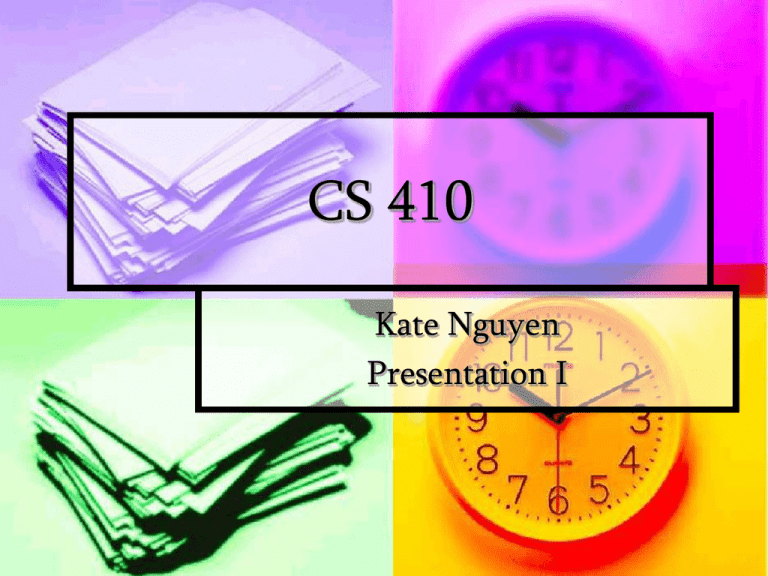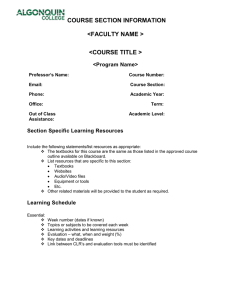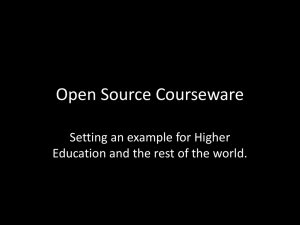CS 410 Kate Nguyen Presentation I
advertisement

CS 410 Kate Nguyen Presentation I Societal Problem In the information age, as our knowledge increases rapidly, textbooks get heavier and environment suffers. Textbooks are getting heavier There are a number of factors that contribute to the size and weight of textbooks. Among them are the NASTA specifications, the lack of unified standards, the use of graphics, interest groups, and the proliferation of content. Source: National Association of State Textbook Administrators (NASTA) Are We Consuming Too Much Paper? World Consumption of paper has grown four hundred percent in the last 40 years. The U.S, which contains only 5% of the world’s population , uses 30% of all paper Pictured is a NASA image of total vegetation in the western hemisphere where most paper is consumed. Source: Ecology, Inc Textbooks & The Paper Industry According to the U.S. Toxic Release Inventory report published by the U.S Environmental Protection Agency, pulp and paper mills are the worst polluters to air, water, and land of any industry in the country. 46% of paper made is cultural paper which used to produce newspaper, books, writing paper, etc. Tree farms help feed the demand for wood, but can’t provide the plant and animal diversity. Using alternatives for wood such as ambary would be costly Source: Food and agriculture organization of the united nations. Ecology Inc. Digital Textbooks Tablet PC Software that converts pdf files to digital format textbook CD-ROMS and other supplementary are integrated into the textbooks Wireless technology make textbooks more lively Touch Screen Windows operating system How Does It Work? Competitions Fujitsu digital textbooks - South Korea - Elementary and middle school E-Books - Rocketbook, Softbook - Missing the ability to work with the screen - No Touch Screen - Eye strains from scrolling Pros Versatility - searchable highlights, making it easier for you to relocate important sections you've marked. - Note taking Portability - Slim, light, can be tucked under arms like a book. - Storage Easily Updated Accessibility - sketching and handwriting are much more familiar form of input than a keyboard and a mouse, especially for people who are new with compute Durability Textbooks are costing more Increasing on an average of 6% a year The price of textbook from 1986 to 2004 has almost tripled Reduce Cost In The Long Run Publishers and vendors save the costs of printing, binding, warehousing, shipping, and handling retailer returns; content updates are vastly easier. Source: Krammin Textbooks Exchange Cons Different publishers, different digital textbooks. --> Standardized PC tablet and digital textbooks Replace teachers? -->The analysis, synthesis and application of that information is what professors, not digital textbook offers Some people like to read on printed textbook Can’t sell used books -->Reduce used books leads to diminishing unnecessary new editions Reference http://www.kramming.com/textbooks-cost-22.php http://thejournal.com/articles/6351 http://jkotherun.blogs.com/jkontherun/2006/02/usa_today_says_. html http://www.campustechnology.com/articles/41713_2/ http://www.wired.com/culture/lifestyle/news/2000/08/38059 http://chronicle.com/free/2002/08/2002082601t.htm http://usgovinfo.about.com/od/consumerawareness/a/gaobookco sts.htm www.umaryland.edu/facultysenate/ documents/Archive/GAO%20Report%20Highlights.pdf http://www.fao.org/docrep/005/v9933e/V9933E01.htm#ch1.4.1 http://www.publishers.org/SchoolDiv/issues/issues_06_SizeWeig ht/SummitSizeWeightTextbooks.pdf



